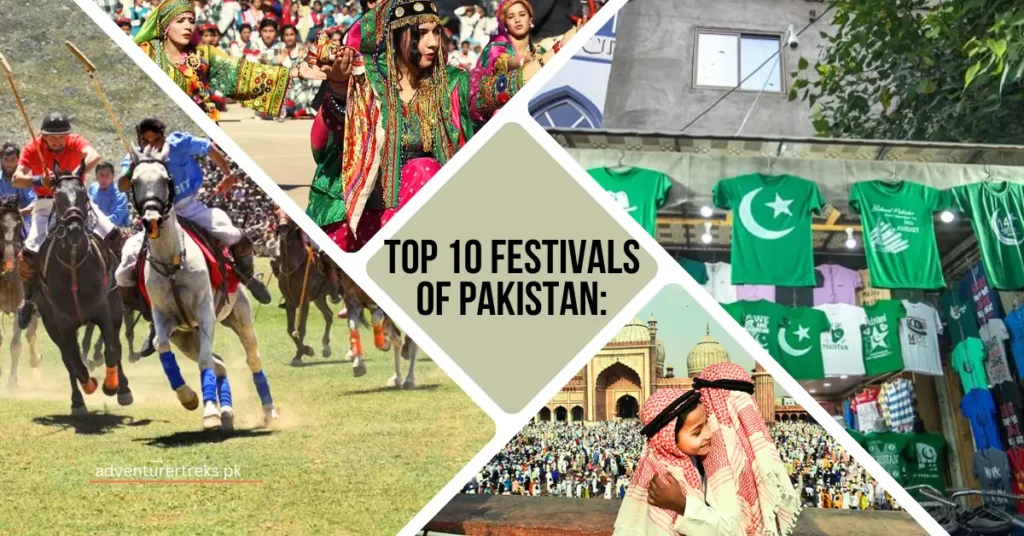Pakistan which is a variety-rich country in terms of cultures and traditions, holds several color festivals in a year. These festivals as a rule highlight the cultural heritage of the country and provide an environment for people to enjoy the spirit of community and connection.
From participating in religious rituals to being part of or hosting a cultural Festivals of Pakistan, Pakistan festivals provide an example of the woven picture of the diversified society of Pakistan.
Top 10 Festivals of Pakistan:
The rich diversity of national festivals of Pakistan is seen in the array of lovely festivals demonstrating the country’s multifaced cultural heritage. Eid al-Fitr and Eid al-Adha are the two blessed days in the Islamic calendar on which Muslims mark the end of the month of Ramadan and offer Qurbani.

The day of the nation’s pride and freedom struggle, Pakistan Day, stands together with Independence Day, in recognition of them.
You will discover a very different side to the region with the sports extravaganza of the Shandur Polo Festival and the traditional Kalash Festival that allows you to peep into ancient rituals.
The act of celebrating the Persian New Year Nowroz welcomes cultural events, and the Mela Sibi as well as the Mela Lok Virsa celebrates cultural heritage through music, dance, and crafts.
Eid ul-Fitr
The Feast of Breaking up the Fast, which is also named Eid ul-Fitr, is an occupied festival of Pakistan for Muslims as a religious community from all over the world. It is the day of Eid that signifies the accomplishment of fasting and contemplation during the blessed month of Ramadan.
With the beginning of the sighting of the Shawwal moon (the new moon), which marks the Eid of Ramadan Muslims are gathering in congregation in mosques or open fields to perform Salat al-Eid which is a special prayer.
These prayers manifest the appreciation for the power and cleverness that were gathered during the fasting period over the one month.
After prayers, people begin to gather, now families and friends together, to enjoy a fun breakfast which is prepared of vermicelli with dried fruits and milk, called “Sewaiyan”.
The essence of Eid ul-Fitr revolves around generosity and kindness. Muslims normally pay the “Zakat al-Fitr,” the almsgiving, before proceeding to the Eid prayers.
The main role of this activity is to create an inclusive environment where all community members can experience the joy and experience of the occasion.
Eid ul-Adha
On the other side, Eid ul-Adha, the “Festival of Sacrifice,” is the most important in Islam. It remembers the heroism of Prophet Ibrahim who was ready to sacrifice his son Isma’il as a sign of his devotion to God.
Nevertheless, before Ibrahim could sacrifice his son, God provided a ram as a substitute, symbolizing divine mercy and acceptance of Ibrahim’s devotion.
It is on the 10th day of Dhu al-Hijjah, the last month of the Islamic calendar that goes with the completion of the Hajj in Mecca. Eid Al-Fitr commences with the Eid prayer.
Muslims will unite in mosques or open spaces to offer prayers of gratitude and remembrance. It is a period of contemplation of the values of sacrifice, obedience, and subjection to the higher power.
The core of Eid ul-Adha is the ritual slaughter of an animal, a goat, a sheep, a cow, or a camel. This is an act that represents Ibrahim’s willingness to give up his most precious possession for the sake of God.
The family shares one-third of the meat amongst themselves, gives another third to their near and dear ones, and distributes the final third to the needy, ensuring no one goes hungry on this blessed day.
Pakistan Day
Every year on March 23, Pakistan celebrates Lahore Resolution Day of 1940, marking the initial step towards attaining Pakistan as an independent state for the Muslims of the Indian subcontinent.
This day makes history, it is the symbol of unity, determination, and resilience of the Pakistani nation which uses freedom and autonomy for its people as a principle.
Various cities hold Pakistan Day parades, raise flags across the country, and organize cultural activities and firework displays.
The armed forces showcased their power and loyalty in a military parade, the most prominent and thrilling activity of the day, held in the capital city of Islamabad, demonstrating their dedication to protecting the country’s independence and national integrity.
Furthermore, Pakistan Day becomes an event for the nation to ponder over the values that the founders of the state prescribed that was most notable of those among them was Quaid-e-Azam Muhammad Ali Jinnah. who desired a Pakistan that was a state that was democratic, progressive, and inclusive.
Independence Day
Independence Day which falls on Aug. 14th, is a festival of Pakistan symbolizing the year Pakistan gained independence from English sovereignty in 1947.
It is a day that is celebrated with national pride and a state of euphoria by Pakistani people as they remember the bloody battle for independence and the day the country was declared a sovereign state.
Hence the speeches the songs, the cultural performances, and the raising of the national flag on government buildings typically begin their celebrations of Independence Day.
People color the streets with flags and buntings, coming together from all walks of life to express their love and admiration for their country and its history, while also honoring the heroes who made great sacrifices for the nation.
Another remarkable moment of the Holiday on Independence Day is the fireworks display whose mysteries create illusions of the fire horizon that signifies the freedom and hopes of our nation.
On the other hand, people demonstrate other water activities like kite flying competitions, cricket matches, and family gatherings that give them a sense of unity and brotherhood.
The Fourth is not merely a day of celebration but submits us to a deeper consideration of the difficulties and opportunities coming in the future.
Defence Day (6th September)
On September 6th, the nation celebrates Defence Day to honor Pakistan’s military forces, commemorating the 1965 Indo-Pak war.
This festival of Pakistan holds a very special place in the hearts of all Pakistanis since it is the day we honor the selfless bravery, resoluteness, and efforts of the armed forces personnel who in turn have sacrificed a lot to protect our motherland and freedom from external enemies.
Celebrations of Defence Day include military parades, flag hoisting ceremonies, and military personnel laying wreaths at War Memorials to honor the martyrs who gave their lives for the country.
In addition, it is an excellent platform to acknowledge the armed forces’ achievements in the preservation of the region’s peace and stability and safeguarding our country from outside aggression and the enjoyment of security it brings.
Defence Day creates the environment for the birth of patriotic feelings and national solidarity among the people of Pakistan.
The services performed by our brave soldiers and their families testify to their endurance through all kinds of tribulations and hazards to preserve their motherland’s independence and security.
Shandur Polo Festival
Many consider the Shandur polo tournament, staged in the middle of July, to be one of Pakistan’s most distinguished cultural and sporting events.
The Shandur Polo Festival takes place at its center, located 3,777 meters above sea level, making it the highest polo ground in the world, equipped with all the necessary facilities to serve its purpose. The rugged topography and sharp peaks of the hills make an unforgettable image for the viewers.
The carnival pulls polo competitors, tourists, and spectators from every part of a wide range of the globe, to see the matches of teams, representing the regions of Gilgit-Baltistan and Khyber Pakhtunkhwa.
Mustangs are much stronger and can gallop over 50 miles per hour, showcasing the skill and athleticism of the riders to negotiate safely without falling on them.
Alongside the polo matches, the Shandur Polo Festival will have a wide range of cultural activities including folklore and folk music and dance shows, exhibition of handicrafts, and stalls selling local food most popular among the attendees.
It enables the attendants of these places to have an acquaintance with the well-rooted cultural heritages of the locality and the soul of the community.
Kalash Festival
The Kalash community in the Chitral district of Pakistan celebrates the Kalash festival, a vibrant and colorful ceremony rich in culture that represents the unique traditional practices of this ancient tribe.
Occurring in May and August during the year, this festival with its music, dancing, rituals and general participation is a unique time for the Kalash people.
While celebrating the festival, the Kalash nation put on its ethnic clothes and strings of precious stones, silver, and other colorful headgear around their heads. In the village squares, they meet for performances of the famous “Chilimjusht” dance that contains gestural movements and synchronous steps.
Music is the core of the celebration, where the sweet tunes of flutes, drums, and xylophones intertwine with the air and create magic by upholding the rituals involved.
Nowroz
The “Nowroz,” one of the oldest Iranian cultural celebrations among the Parsis and Ismaili Shia communities, usually celebrated in March has two meanings. One is the “vernal equinox” which represents the first day of the New Year and the second is “the rebirth of nature.”
This festival of Pakistan takes place on the vernal equinox, typically on March 21, and is considered the first day of spring and a sign of nature’s rebirth.
Nowroz is the time of rejoicing, it’s the time to repent, and it’s the time to rededicate ourselves to good deeds, for people get together with their family and friends to welcome a new year.
Although families may differ slightly in their rituals, they usually start the celebrations with thorough cleaning and decorating of their homes, followed by visits to the graves of their deceased loved ones, praying, and expressing their gratitude.
A principal ‘custom’ of Nowroz is usually the establishment of a ‘Haft Sin‘ table which is abundantly trimmed with seven symbolic elements that mean the facets of nature and fertility.
The list comprises wheat sprouts, apples, garlic, vinegar sumac, coins, and a mirror each of which carries good meaning and a blessing for a prosperous year.
Sibi Mela
Every year, the city of Sibi in the former Balochistan province hosts Sibi Mela, the cultural festivals of Pakistan, which rightly ranks among the most awaited cultural activities in the country.
This event usually lasts 7 days in February but can extend until the beginning of March, during which it hosts many visitors from around the country.
Sibi festival brings all the colors of the Balochi culture on the platter, with its musical enthralling dance, handicrafts, and various food delicacies.
The most striking event of the show is the livestock show, in which breeders throughout Balochistan and neighboring regions present their most beautiful cows, camels, and horses.
Apart from the livestock show, the Sibi Fair also provides different sources of entertainment which you will find in folk singing, dancing, acrobatics, and many other various forms of cultural entertainment programs.
Moreover, the visitor can also come across stalls selling different kinds of Baloch artists like carpets, rugs, embroidery, pottery, and leather work, displaying the top-notch skills of the local craftsmen.
Lok Virsa Mela
The Lok Virsa Mela at the Lok Virsa Institute of Folk and Traditional Heritage (LIFTAH) offers attendees the opportunity to explore various aspects of Pakistani cultural heritage.
Though held annually in Islamabad city Lok Virsa Mela gathers artisans, performers, and visitors both from all over the country to promote and embrace the precious traditional art and crafts of Pakistan as well.
The Lok Virsa Mela in itself is a plethora of events from folk music and dance performances, to craft bazaars, live storytelling sessions to ancestral games.
Visitors can get to know stores selling handmade pottery, textiles, jewelry, woodwork, and other crafts, while at the same they support local craftsmen who pass their mastership to the younger generation.
Lok Virsa Mela is probably most known for its “Cultural Parade” in which participants exhibit they are wearing traditional costumes of all regions of Pakistan, and they parade along the festival area, demonstrating the cultural richness of their land.
These festivals of Pakistan include workshops on folk art performances, seminars, and literature related to the exhibition; it aims to spread information and understanding of our Intangible Cultural Heritage.







